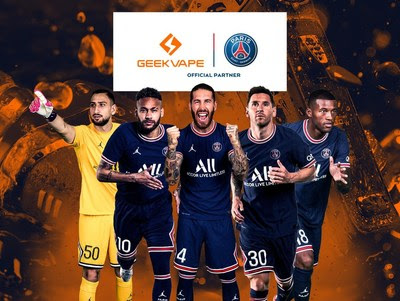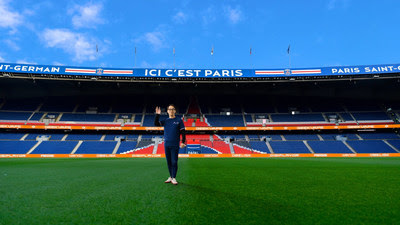Le 15 février, le Paris Saint-Germain a battu le Real Madrid lors du match aller de la Ligue des champions au Parc des Princes. Le but de Mbappe dans les arrêts de jeu a permis au PSG de s’imposer 1-0 face au Real Madrid.
PARIS, 18 février 2022 /PRNewswire/ — Le même jour, GEEKVAPE a organisé le lancement de nouveaux produits « SHAPE THE FUTURE » à Paris, en France, et a officiellement lancé trois nouveaux produits de l’édition Paris Saint-Germain. GEEKVAPE est devenue la première marque de son secteur à s’aventurer sur un terrain de football international, captant ainsi l’attention des fans du monde entier.

Le partenariat entre le Paris Saint-Germain et GEEKVAPE a été largement médiatisé depuis son annonce. Ces produits très attendus sont enfin arrivés sur le marché.
GEEKVAPE a relevé la barre en matière de mod, de pod mod et de conception de produits pod. Il s’agit de l’Obelisk 65FC, qui incarne la technologie de pointe du secteur, du Geekvape S100, dont le corps est en acier inoxydable, et du Geekvape 1FC, le premier pod mod à charge rapide au monde. Chacun des trois produits est peint dans une teinte bleue française.
Toutefois, les droits et intérêts de la collaboration vont au-delà. GEEKVAPE dispose d’un salon VIP GeekFams unique au Parc des Princes, et ses précieux clients seront invités à profiter d’une expérience VIP. GEEKVAPE distribuera également des produits dérivés du PSG dédicacés à l’occasion, et les GeekFams auront la possibilité de devenir des ambassadeurs Geek et d’être invités au stade pour rencontrer les joueurs de près.
Comme nous le savons tous, l’ensemble du secteur est en difficulté cette année en raison de l’influence du COVID-19. Malgré de nombreux obstacles, l’équipe de GEEKVAPE a obtenu des résultats remarquables.
En 2021, GEEKVAPE a continué à consolider la position de la première marque de BOX MOD, et son système de produits était plus que cela. Cette année, GEEKVAPE est entré sur le marché des pods et des jetables, réalisant la disposition complète des catégories de trois catégories et cinq séries. Ils ont également obtenu la reconnaissance des médias et des partenaires de l’industrie. GEEKVAPE a reçu de nombreux prix internationaux, notamment les prestigieux Vapouround Awards et Ecigclick Awards.

Le réseau de vente mondial de GEEKVAPE couvre désormais plus de 60 pays et régions et a maintenu une croissance rapide pendant cinq années consécutives. De plus en plus de consommateurs se tournent désormais vers les produits GEEKVAPE, et ses technologies sont adoptées par un nombre croissant de partenaires. Le lancement de produits co-marqués avec PSG est un pas important vers la relance de l’industrie.
Depuis longtemps, GEEKVAPE est à l’avant-garde du secteur, s’efforçant constamment de créer de meilleurs produits pour les clients et recherchant le concept ultime de produit et de technologie. Cette démarche audacieuse et innovante a augmenté l’influence mondiale de la marque ainsi que sa culture de marque.
« En collaborant avec le Paris Saint-Germain, nous sommes en mesure d’intégrer des thèmes liés à la vie et au sport, ce qui se traduit par une culture de marque plus diversifiée qui inspire les gens », a déclaré M. Potti, directeur du marketing de GEEKVAPE. GEEKVAPE est sur le point de percer sur la scène mondiale dans un avenir proche.
